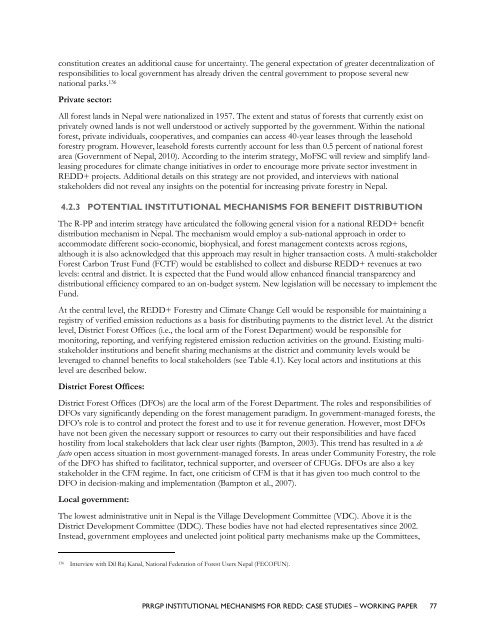Institutional Mechanisms for REDD+ - Case Studies Working Paper
Institutional Mechanisms for REDD+ - Case Studies Working Paper
Institutional Mechanisms for REDD+ - Case Studies Working Paper
Create successful ePaper yourself
Turn your PDF publications into a flip-book with our unique Google optimized e-Paper software.
constitution creates an additional cause <strong>for</strong> uncertainty. The general expectation of greater decentralization of<br />
responsibilities to local government has already driven the central government to propose several new<br />
national parks. 136<br />
Private sector:<br />
All <strong>for</strong>est lands in Nepal were nationalized in 1957. The extent and status of <strong>for</strong>ests that currently exist on<br />
privately owned lands is not well understood or actively supported by the government. Within the national<br />
<strong>for</strong>est, private individuals, cooperatives, and companies can access 40-year leases through the leasehold<br />
<strong>for</strong>estry program. However, leasehold <strong>for</strong>ests currently account <strong>for</strong> less than 0.5 percent of national <strong>for</strong>est<br />
area (Government of Nepal, 2010). According to the interim strategy, MoFSC will review and simplify landleasing<br />
procedures <strong>for</strong> climate change initiatives in order to encourage more private sector investment in<br />
<strong>REDD+</strong> projects. Additional details on this strategy are not provided, and interviews with national<br />
stakeholders did not reveal any insights on the potential <strong>for</strong> increasing private <strong>for</strong>estry in Nepal.<br />
4.2.3 POTENTIAL INSTITUTIONAL MECHANISMS FOR BENEFIT DISTRIBUTION<br />
The R-PP and interim strategy have articulated the following general vision <strong>for</strong> a national <strong>REDD+</strong> benefit<br />
distribution mechanism in Nepal. The mechanism would employ a sub-national approach in order to<br />
accommodate different socio-economic, biophysical, and <strong>for</strong>est management contexts across regions,<br />
although it is also acknowledged that this approach may result in higher transaction costs. A multi-stakeholder<br />
Forest Carbon Trust Fund (FCTF) would be established to collect and disburse <strong>REDD+</strong> revenues at two<br />
levels: central and district. It is expected that the Fund would allow enhanced financial transparency and<br />
distributional efficiency compared to an on-budget system. New legislation will be necessary to implement the<br />
Fund.<br />
At the central level, the <strong>REDD+</strong> Forestry and Climate Change Cell would be responsible <strong>for</strong> maintaining a<br />
registry of verified emission reductions as a basis <strong>for</strong> distributing payments to the district level. At the district<br />
level, District Forest Offices (i.e., the local arm of the Forest Department) would be responsible <strong>for</strong><br />
monitoring, reporting, and verifying registered emission reduction activities on the ground. Existing multistakeholder<br />
institutions and benefit sharing mechanisms at the district and community levels would be<br />
leveraged to channel benefits to local stakeholders (see Table 4.1). Key local actors and institutions at this<br />
level are described below.<br />
District Forest Offices:<br />
District Forest Offices (DFOs) are the local arm of the Forest Department. The roles and responsibilities of<br />
DFOs vary significantly depending on the <strong>for</strong>est management paradigm. In government-managed <strong>for</strong>ests, the<br />
DFO‘s role is to control and protect the <strong>for</strong>est and to use it <strong>for</strong> revenue generation. However, most DFOs<br />
have not been given the necessary support or resources to carry out their responsibilities and have faced<br />
hostility from local stakeholders that lack clear user rights (Bampton, 2003). This trend has resulted in a de<br />
facto open access situation in most government-managed <strong>for</strong>ests. In areas under Community Forestry, the role<br />
of the DFO has shifted to facilitator, technical supporter, and overseer of CFUGs. DFOs are also a key<br />
stakeholder in the CFM regime. In fact, one criticism of CFM is that it has given too much control to the<br />
DFO in decision-making and implementation (Bampton et al., 2007).<br />
Local government:<br />
The lowest administrative unit in Nepal is the Village Development Committee (VDC). Above it is the<br />
District Development Committee (DDC). These bodies have not had elected representatives since 2002.<br />
Instead, government employees and unelected joint political party mechanisms make up the Committees,<br />
136 Interview with Dil Raj Kanal, National Federation of Forest Users Nepal (FECOFUN).<br />
PRRGP INSTITUTIONAL MECHANISMS FOR REDD: CASE STUDIES – WORKING PAPER 77

















